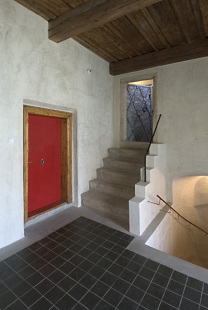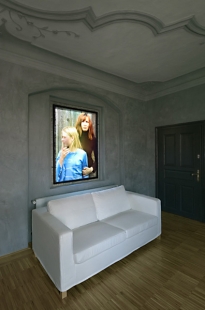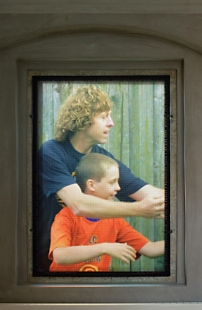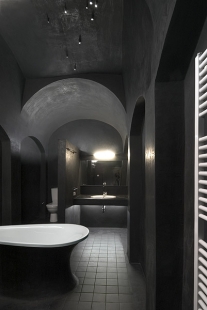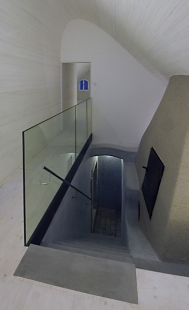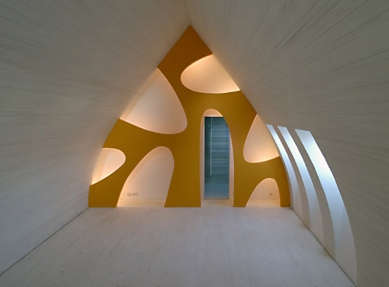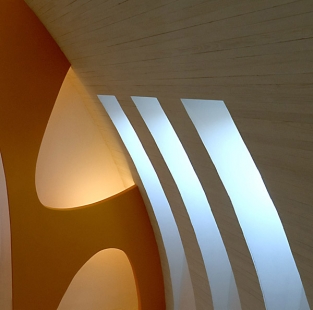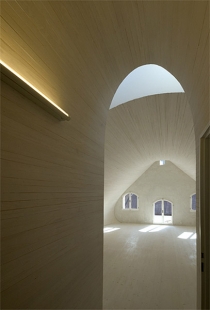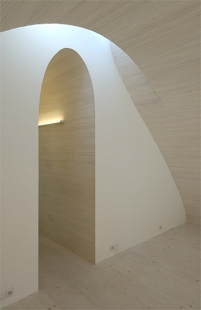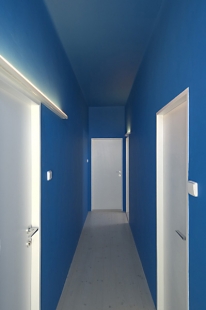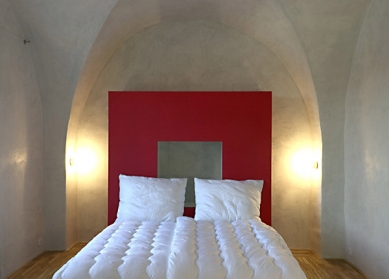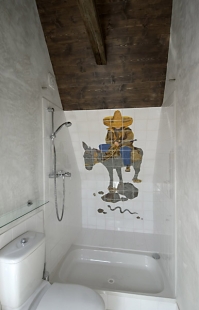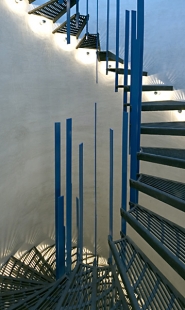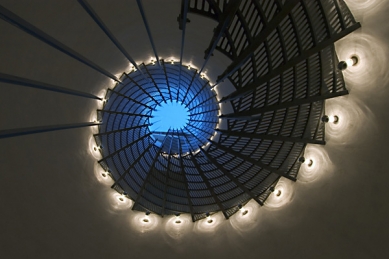
Gathering

I solemnly promise that as soon as possible, we will all embark on an expedition to Slavonice and spend the night in this amazing house. Each editorial member will then write a brief commentary about their impressions and experiences. I will reserve Vávra. But I will come to bathe in Boháč...
HOW TO WRITE ABOUT A HOUSE
The first time I saw the house was in the June setting sun of 1988. Abandoned, with blind windows and peeling facade. Perhaps that made it more mysterious than others, standing in a totally forgotten totalitarian town at the border of no man's land. When I proposed that we buy the house, I was first considered a madman, probably rightfully so. But I convinced my friends, and in the spring of 1989, seven brave souls from the Sklep theater and the Wife of Nations became the owners of this treasure. On the memorable tile in the floor of the Besídka, it still states that at that time totalitarianism was so deep that we could not see even the tip of our noses, and the farthest we ventured was to the cupboard. On our third visit, we realized that the voices of owls warning against joint ownership were not entirely unfounded. We had no money, no time, and no common idea. There were only four barely habitable rooms in the house, and there were eight of us. If it hadn’t been for the pivotal year of 1989, the house would probably have continued to deteriorate until it fell apart. Fortunately, the events of November shot me into the free world, and I left the big city to become a restaurateur as well as a restorer. The first renovation of the Besídka in 1990, almost without a project, and also without approval, was euphoric and amateurish, just like the times back then. However, it gave rise to a specific atmosphere that became characteristic of the Besídka. I would almost say that just as a sculpture is hidden in every stone, so the essence of the Besídka was hidden in the material of the house. We were just fortunate to discover it. But after fifteen years of operating without approval, fatigue set in for materials, people, and visitors, and the idea of the house began to fade along with the sagging ceiling and burnt aluminum wires. After fifteen years of experience, it was finally time to write a script, or rather a literary template, so that the architect, as the director, could create a piece that would give the material timeless validity. This is certainly not modest, and the bar is indeed set high, but it is worth a try. In fact, it is very simple. At the beginning, there were eight of us, so there must be as many rooms in the house, and since each of us is different, they will also be different, so that they tell something about their spiritual owner. The spirit of the Besídka must be preserved; it just needs to be extracted more from the material, so it doesn’t end right behind the doors of the pub, but permeates the entire house, even into its most intimate places. If my wife Vladimíra hadn’t reassured me many times that it was possible, I probably would never have set out after Roman Koucký. He had a special qualification for this task. He was a person who understood this essence, also due to the time he spent in the Besídka, while he was not one of us, and primarily, he was a partner. That possibility of a permanent dialogue over every detail also gave me, the investor, the intoxicating feeling of creation and enthusiasm over every new idea and the suffering over technical problems or statements from preservationists. By having the opportunity to become a co-creator, I penetrated deeper into the innards of the house, understood their functions, and often changed my opinion on the final execution. It was like modifying a script on the fly. If I hadn’t been so closely involved in these events, the end result would certainly have been different, worse, and less functional. Similarly, I believe that an architect, a director, can also be bolder and more assured of the investor's support. If I am to continue with the theatrical paraphrase, if there is understanding between the screenwriter and the director, one only needs a lucky hand in selecting the main actors. They, being personalities, also enter into the dialogue between the screenwriter and the director and conclude the discussion with their perspective from within, transforming the originally individualistic activity into teamwork. It is now up to the visitors and guests to assess whether the enthusiasm for the completed work is adequate to the result, but even destructive contempt cannot diminish the awareness that the house stands and stands as we wanted it to.
Jan Boháč
The following texts are from the website of the Besídka:
Pre-Sklep History
If we are to talk about the house, we must briefly mention the history of the surrounding town. It was founded in the 13th century by Přemysl Otakar II in the vicinity of an original Slavic village. The Iron and Golden King invited German colonists to this nearly deserted borderland, unaware that this would influence the town's history until the 21st century. In 1278, shortly before his death at the nearby Moravian field, he ordered the city to be fortified, and in 1359, his no less famous successor Charles IV granted city rights to the town. The walls came in handy multiple times, first against the Hussites, who burned the suburbs in 1423 but could not capture the city, and also during the Thirty Years' War, when the imperial army attempted several times to seize the city - a bastion of Protestants. It was not until 1645 that the Swedes occupied it without resistance and plundered it. Coincidentally, these were otherwise golden times for Slavonice. In 1560, a postal station was established on the route from Prague to Vienna, and until its closure and relocation to Znojmo in 1750, the town grew rich and prospered. Then began a long decline, with a brief revival in the first half of the 20th century, followed by a dark period of post-war displacement and sleepy isolation in the totalitarian border region.
And what about the Besídka? In its birth certificate, we read: Date of birth - unknown. Unfortunately, during World War II and shortly after, most documents from the city archive were irretrievably lost. The beginnings can only be inferred from architectural historical surveys and the general history of the town. It is certain that the oldest part is the cellars, probably dating back to the 13th century. When you wander into the basement to the fountain and the toilets, know that someone looked up at the vault above you seven hundred years ago. The perimeter walls of the house are probably Gothic. Gothic framing of a small window between the kitchen windows in the courtyard also attests to this. Finally, the Renaissance comes with the date 1547, which is the year of the completion of a major reconstruction of the house. At that time, the original, perhaps wooden ceilings were removed and replaced with ribbed vaults on stone columns. The facade was also newly adjusted and decorated with sgraffito. The older version can only be found in Prague, and that is only two years older. The pub and passage formed, for a short time, the largest vaulted space in Slavonice. Very soon, still in the 16th century, however, they were divided by a partition on which fragments of frescoes with German inscriptions remain. Next to the vaults, the owner, probably a grateful subject, had the coats of arms of his lords, Mr. Zachariáš of Hradec and his wife Kateřina of Valdštejn, immortalized. The scenes on the sgraffito of the street facade are almost faithful copies of woodcuts from Luther's Wartburg Bible of 1534. Among the Old Testament images, at the top of the gable, are Cain and Abel sacrificing to God, in the band under the windows, Samson tearing a lion apart, striking the Philistines, and obtaining water from the jaw of a donkey. Above the windows in the architrave are ten phases of life from birth to death. In the lunette between the stone corbels are Old Testament figures: Sarah, Job, Aaron, Jacob, Joshua, and Saul. On the left side, a part of a painting of Moses holding the tablets of the law was rediscovered in 1992. In the last field under the window on the right, there is a textile sign with the letters P. P., perhaps the initials of the then owner. If we proceed to the first courtyard, one cannot fail to notice the Venetian arched shield with a large Renaissance window restored in 2004. Even in the back part of the house, Gothic perimeter walls prevail, into which ribbed vaults were built in the 16th century. The builders of the time did not worry too much about the stability of the house, so they simply glued the vaults to the perimeter walls without tying them to the original construction in any way. Cracks that developed over several centuries reached up to 6 cm, and so today the house is held together by a series of rods. If we ascend the broken staircase to the first floor, we find ourselves in a hall with a Renaissance wooden ceiling and a restored window to the inner courtyard. The main hall to the right of the staircase, as well as the room to the left, hide the same Renaissance structure under Rococo or Baroque stucco work. Gothic iron doors with stone framing were bricked into the body of the staircase, embedded into the original house sometime in the second half of the 19th century. How the inhabitants accessed the first floor and the attic before that is a mystery. Another mystery is the underground corridor in the second floor of the basement. Today it is partially flooded and at the end, collapsed. Perhaps it was part of the now rediscovered underground labyrinth of Slavonice. Baroque did not only grant the house stucco ceilings, but in accordance with fashion, the sgraffito facade was whitened and the cornices on the gable were adjusted. It had to wait until the 1950s for its revelation. The house faced its greatest danger during the First Republic when the owner, the hat maker Ferdinand Zimmer, wanted to open a hat salon in the passage and, needing a larger and brighter display, intended to replace the stone brackets supporting the first floor with beams. Fortunately, the house was already protected as a monument at that time, and so such an unfortunate intervention was not permitted. This master hat maker was also the last German owner of the house. However, this German had a Czech wife, and thus, as one of the few, he remained in the town even after 1945. However, he did not last long; he could not cope with the new situation, so he sold the house and moved inland with his family. The next owner was Mr. Kostroun, who lived in the house until about the mid-seventies, but then he could not resist the comfort of panel walls and central heating, and the house remained almost 16 years abandoned. And the rest is a different chapter.
Sklep History
In 1988, the Sklep theater discovered Slavonice. One of the most prominent personalities from Sklep, artist of life Zdeněk Žampa, known as Žampič, invited other theater companions to "Barchan" in nearby Jemnice. This mythical celebration at the beginning of summer, reminiscent of Queen Kunhuta's overnight stay in this region, brought everyone to Slavonice, where they all stayed overnight in Žampič's family house. When Jan Boháč saw the abandoned dilapidated house across the street in the rays of the almost noon sun the next morning, he perhaps did not even realize that it would become fateful for him for a considerable part of his life. The idea of buying such a ruin in a remote border town, a few meters from the Iron Curtain, was so absurd that it found support from seven other enthusiasts. Within a year, the house called them gentlemen. But soon the question "What to do with it?" almost became a Nerudian problem. Fortunately, the revolution came in time, along with new possibilities. Messrs. Boháč and Žampa eagerly abandoned their engineering professions and began to realize goals of higher values, namely the establishment of their own Sklep restaurant. With twenty thousand crowns of their own savings, no experience from the other side of the bar counter, and naive ideas of early capitalism, they laid the cornerstone of the "Besídka" at the beginning of January. The name of the most famous and oldest Sklep performance seemed to come naturally to the house. Within nearly six months, on June 15, 1990, a bus stopped in front of the Besídka and discharged the rest of the Sklep crew. The band started up, and Lenka Vychodilová and Tomáš Hanák christened the house with the ritual song "Sklepovská Besídka begins." While the pub was lively, in the courtyard, artist Kryštof Trubáček was tirelessly chopping wood to prepare everything for the First Annual "International Summer School of Spiritual Experimentation in Theory and Practice." So grandly named, the reality far exceeded expectations. The first students from Italy, Germany, and Austria, who overcame their fear and arrived in a country barely awakened from its totalitarian slumber, were richly rewarded with an unforgettable fireworks display of ideas, pranks, and pure joy that radiated from all the instructors of the school. David Vávra mimed collages, Aleš Najbrt danced calligraphically, and Čestmír Suška carved wooden figures, while Martina Riedelbauchová and Tereza Kučerová gently decorated the walls and doors. Thus, the Besídka transformed summer after summer for a full ten years. The euphoric enthusiasm of the first summer at the Besídka also inspired Jan Boháč to write the partially autobiographical novel "And then you will see..." published by Maťa in 2000. While the enthusiasm and activity remained high throughout, the house did wear down. The demands for accommodation increased, and what was once the entertaining color of the early post-revolution years became an obstacle for a more qualitative experience for participants. The reconstruction, somewhat hastily done in 1990, needed to be completed. The time came in 2003 when, by then, the only operators of the Besídka—the Boháč family—had gathered enough resources and energy to complete the work. They therefore joined forces with Roman Koucký and his architectural studio to breathe new energy into the Besídka. This was not a random choice, but a targeted one, as the house needed someone who knew it well but at the same time stood a bit apart from the main Besídka-Sklep flow. However, this was not an easy task, as the house had already lived its own life, which needed to be preserved while elevating it to a higher level. Today, the original bar counter with painted tiles by Kryštof Trubáček stands alongside the air conditioning unit by Martin Ceplechy. Overall, however, the visitor does not feel any significant change in the pub itself. However, this does not apply to the rest of the house. Accommodation is at a three-star hotel level, but it is not the anonymous place of mere overnight stays but an aesthetic and spiritual experience. The rooms are not numbered but bear the names of the eight original owners, who thus remain present in the house not only by name but whose spirit can be found in every room. Behind the courtyard, in the birthplace of the idea of Maříž ceramics, is a pottery workshop where you can paint your own mug or vase. On the first floor overlooking the square, in a large hall with Rococo plasterwork, you can hold a lecture, seminar, or practice yoga, as well as rehearse a theater play. It is the visitors who will assess whether the original spirit of the Besídka has been preserved and whether the words of the legendary song "Sklepovská Besídka begins, may it always be the same, always different" have been fulfilled.
Jan Kratochvíl
HOW TO WRITE ABOUT A HOUSE
The first time I saw the house was in the June setting sun of 1988. Abandoned, with blind windows and peeling facade. Perhaps that made it more mysterious than others, standing in a totally forgotten totalitarian town at the border of no man's land. When I proposed that we buy the house, I was first considered a madman, probably rightfully so. But I convinced my friends, and in the spring of 1989, seven brave souls from the Sklep theater and the Wife of Nations became the owners of this treasure. On the memorable tile in the floor of the Besídka, it still states that at that time totalitarianism was so deep that we could not see even the tip of our noses, and the farthest we ventured was to the cupboard. On our third visit, we realized that the voices of owls warning against joint ownership were not entirely unfounded. We had no money, no time, and no common idea. There were only four barely habitable rooms in the house, and there were eight of us. If it hadn’t been for the pivotal year of 1989, the house would probably have continued to deteriorate until it fell apart. Fortunately, the events of November shot me into the free world, and I left the big city to become a restaurateur as well as a restorer. The first renovation of the Besídka in 1990, almost without a project, and also without approval, was euphoric and amateurish, just like the times back then. However, it gave rise to a specific atmosphere that became characteristic of the Besídka. I would almost say that just as a sculpture is hidden in every stone, so the essence of the Besídka was hidden in the material of the house. We were just fortunate to discover it. But after fifteen years of operating without approval, fatigue set in for materials, people, and visitors, and the idea of the house began to fade along with the sagging ceiling and burnt aluminum wires. After fifteen years of experience, it was finally time to write a script, or rather a literary template, so that the architect, as the director, could create a piece that would give the material timeless validity. This is certainly not modest, and the bar is indeed set high, but it is worth a try. In fact, it is very simple. At the beginning, there were eight of us, so there must be as many rooms in the house, and since each of us is different, they will also be different, so that they tell something about their spiritual owner. The spirit of the Besídka must be preserved; it just needs to be extracted more from the material, so it doesn’t end right behind the doors of the pub, but permeates the entire house, even into its most intimate places. If my wife Vladimíra hadn’t reassured me many times that it was possible, I probably would never have set out after Roman Koucký. He had a special qualification for this task. He was a person who understood this essence, also due to the time he spent in the Besídka, while he was not one of us, and primarily, he was a partner. That possibility of a permanent dialogue over every detail also gave me, the investor, the intoxicating feeling of creation and enthusiasm over every new idea and the suffering over technical problems or statements from preservationists. By having the opportunity to become a co-creator, I penetrated deeper into the innards of the house, understood their functions, and often changed my opinion on the final execution. It was like modifying a script on the fly. If I hadn’t been so closely involved in these events, the end result would certainly have been different, worse, and less functional. Similarly, I believe that an architect, a director, can also be bolder and more assured of the investor's support. If I am to continue with the theatrical paraphrase, if there is understanding between the screenwriter and the director, one only needs a lucky hand in selecting the main actors. They, being personalities, also enter into the dialogue between the screenwriter and the director and conclude the discussion with their perspective from within, transforming the originally individualistic activity into teamwork. It is now up to the visitors and guests to assess whether the enthusiasm for the completed work is adequate to the result, but even destructive contempt cannot diminish the awareness that the house stands and stands as we wanted it to.
Jan Boháč
The following texts are from the website of the Besídka:
Pre-Sklep History
If we are to talk about the house, we must briefly mention the history of the surrounding town. It was founded in the 13th century by Přemysl Otakar II in the vicinity of an original Slavic village. The Iron and Golden King invited German colonists to this nearly deserted borderland, unaware that this would influence the town's history until the 21st century. In 1278, shortly before his death at the nearby Moravian field, he ordered the city to be fortified, and in 1359, his no less famous successor Charles IV granted city rights to the town. The walls came in handy multiple times, first against the Hussites, who burned the suburbs in 1423 but could not capture the city, and also during the Thirty Years' War, when the imperial army attempted several times to seize the city - a bastion of Protestants. It was not until 1645 that the Swedes occupied it without resistance and plundered it. Coincidentally, these were otherwise golden times for Slavonice. In 1560, a postal station was established on the route from Prague to Vienna, and until its closure and relocation to Znojmo in 1750, the town grew rich and prospered. Then began a long decline, with a brief revival in the first half of the 20th century, followed by a dark period of post-war displacement and sleepy isolation in the totalitarian border region.
And what about the Besídka? In its birth certificate, we read: Date of birth - unknown. Unfortunately, during World War II and shortly after, most documents from the city archive were irretrievably lost. The beginnings can only be inferred from architectural historical surveys and the general history of the town. It is certain that the oldest part is the cellars, probably dating back to the 13th century. When you wander into the basement to the fountain and the toilets, know that someone looked up at the vault above you seven hundred years ago. The perimeter walls of the house are probably Gothic. Gothic framing of a small window between the kitchen windows in the courtyard also attests to this. Finally, the Renaissance comes with the date 1547, which is the year of the completion of a major reconstruction of the house. At that time, the original, perhaps wooden ceilings were removed and replaced with ribbed vaults on stone columns. The facade was also newly adjusted and decorated with sgraffito. The older version can only be found in Prague, and that is only two years older. The pub and passage formed, for a short time, the largest vaulted space in Slavonice. Very soon, still in the 16th century, however, they were divided by a partition on which fragments of frescoes with German inscriptions remain. Next to the vaults, the owner, probably a grateful subject, had the coats of arms of his lords, Mr. Zachariáš of Hradec and his wife Kateřina of Valdštejn, immortalized. The scenes on the sgraffito of the street facade are almost faithful copies of woodcuts from Luther's Wartburg Bible of 1534. Among the Old Testament images, at the top of the gable, are Cain and Abel sacrificing to God, in the band under the windows, Samson tearing a lion apart, striking the Philistines, and obtaining water from the jaw of a donkey. Above the windows in the architrave are ten phases of life from birth to death. In the lunette between the stone corbels are Old Testament figures: Sarah, Job, Aaron, Jacob, Joshua, and Saul. On the left side, a part of a painting of Moses holding the tablets of the law was rediscovered in 1992. In the last field under the window on the right, there is a textile sign with the letters P. P., perhaps the initials of the then owner. If we proceed to the first courtyard, one cannot fail to notice the Venetian arched shield with a large Renaissance window restored in 2004. Even in the back part of the house, Gothic perimeter walls prevail, into which ribbed vaults were built in the 16th century. The builders of the time did not worry too much about the stability of the house, so they simply glued the vaults to the perimeter walls without tying them to the original construction in any way. Cracks that developed over several centuries reached up to 6 cm, and so today the house is held together by a series of rods. If we ascend the broken staircase to the first floor, we find ourselves in a hall with a Renaissance wooden ceiling and a restored window to the inner courtyard. The main hall to the right of the staircase, as well as the room to the left, hide the same Renaissance structure under Rococo or Baroque stucco work. Gothic iron doors with stone framing were bricked into the body of the staircase, embedded into the original house sometime in the second half of the 19th century. How the inhabitants accessed the first floor and the attic before that is a mystery. Another mystery is the underground corridor in the second floor of the basement. Today it is partially flooded and at the end, collapsed. Perhaps it was part of the now rediscovered underground labyrinth of Slavonice. Baroque did not only grant the house stucco ceilings, but in accordance with fashion, the sgraffito facade was whitened and the cornices on the gable were adjusted. It had to wait until the 1950s for its revelation. The house faced its greatest danger during the First Republic when the owner, the hat maker Ferdinand Zimmer, wanted to open a hat salon in the passage and, needing a larger and brighter display, intended to replace the stone brackets supporting the first floor with beams. Fortunately, the house was already protected as a monument at that time, and so such an unfortunate intervention was not permitted. This master hat maker was also the last German owner of the house. However, this German had a Czech wife, and thus, as one of the few, he remained in the town even after 1945. However, he did not last long; he could not cope with the new situation, so he sold the house and moved inland with his family. The next owner was Mr. Kostroun, who lived in the house until about the mid-seventies, but then he could not resist the comfort of panel walls and central heating, and the house remained almost 16 years abandoned. And the rest is a different chapter.
Sklep History
In 1988, the Sklep theater discovered Slavonice. One of the most prominent personalities from Sklep, artist of life Zdeněk Žampa, known as Žampič, invited other theater companions to "Barchan" in nearby Jemnice. This mythical celebration at the beginning of summer, reminiscent of Queen Kunhuta's overnight stay in this region, brought everyone to Slavonice, where they all stayed overnight in Žampič's family house. When Jan Boháč saw the abandoned dilapidated house across the street in the rays of the almost noon sun the next morning, he perhaps did not even realize that it would become fateful for him for a considerable part of his life. The idea of buying such a ruin in a remote border town, a few meters from the Iron Curtain, was so absurd that it found support from seven other enthusiasts. Within a year, the house called them gentlemen. But soon the question "What to do with it?" almost became a Nerudian problem. Fortunately, the revolution came in time, along with new possibilities. Messrs. Boháč and Žampa eagerly abandoned their engineering professions and began to realize goals of higher values, namely the establishment of their own Sklep restaurant. With twenty thousand crowns of their own savings, no experience from the other side of the bar counter, and naive ideas of early capitalism, they laid the cornerstone of the "Besídka" at the beginning of January. The name of the most famous and oldest Sklep performance seemed to come naturally to the house. Within nearly six months, on June 15, 1990, a bus stopped in front of the Besídka and discharged the rest of the Sklep crew. The band started up, and Lenka Vychodilová and Tomáš Hanák christened the house with the ritual song "Sklepovská Besídka begins." While the pub was lively, in the courtyard, artist Kryštof Trubáček was tirelessly chopping wood to prepare everything for the First Annual "International Summer School of Spiritual Experimentation in Theory and Practice." So grandly named, the reality far exceeded expectations. The first students from Italy, Germany, and Austria, who overcame their fear and arrived in a country barely awakened from its totalitarian slumber, were richly rewarded with an unforgettable fireworks display of ideas, pranks, and pure joy that radiated from all the instructors of the school. David Vávra mimed collages, Aleš Najbrt danced calligraphically, and Čestmír Suška carved wooden figures, while Martina Riedelbauchová and Tereza Kučerová gently decorated the walls and doors. Thus, the Besídka transformed summer after summer for a full ten years. The euphoric enthusiasm of the first summer at the Besídka also inspired Jan Boháč to write the partially autobiographical novel "And then you will see..." published by Maťa in 2000. While the enthusiasm and activity remained high throughout, the house did wear down. The demands for accommodation increased, and what was once the entertaining color of the early post-revolution years became an obstacle for a more qualitative experience for participants. The reconstruction, somewhat hastily done in 1990, needed to be completed. The time came in 2003 when, by then, the only operators of the Besídka—the Boháč family—had gathered enough resources and energy to complete the work. They therefore joined forces with Roman Koucký and his architectural studio to breathe new energy into the Besídka. This was not a random choice, but a targeted one, as the house needed someone who knew it well but at the same time stood a bit apart from the main Besídka-Sklep flow. However, this was not an easy task, as the house had already lived its own life, which needed to be preserved while elevating it to a higher level. Today, the original bar counter with painted tiles by Kryštof Trubáček stands alongside the air conditioning unit by Martin Ceplechy. Overall, however, the visitor does not feel any significant change in the pub itself. However, this does not apply to the rest of the house. Accommodation is at a three-star hotel level, but it is not the anonymous place of mere overnight stays but an aesthetic and spiritual experience. The rooms are not numbered but bear the names of the eight original owners, who thus remain present in the house not only by name but whose spirit can be found in every room. Behind the courtyard, in the birthplace of the idea of Maříž ceramics, is a pottery workshop where you can paint your own mug or vase. On the first floor overlooking the square, in a large hall with Rococo plasterwork, you can hold a lecture, seminar, or practice yoga, as well as rehearse a theater play. It is the visitors who will assess whether the original spirit of the Besídka has been preserved and whether the words of the legendary song "Sklepovská Besídka begins, may it always be the same, always different" have been fulfilled.
The English translation is powered by AI tool. Switch to Czech to view the original text source.
4 comments
add comment
Subject
Author
Date
a
honzaw
24.09.05 08:43
Na pravou míru
LIbor Karásek, Slavonice
26.11.06 11:31
Díky za informaci
Petr Hnátek
23.07.08 08:23
Vzpomínka na paní Zimmerovou
Zdeněk Žampa
31.07.12 11:09
show all comments



